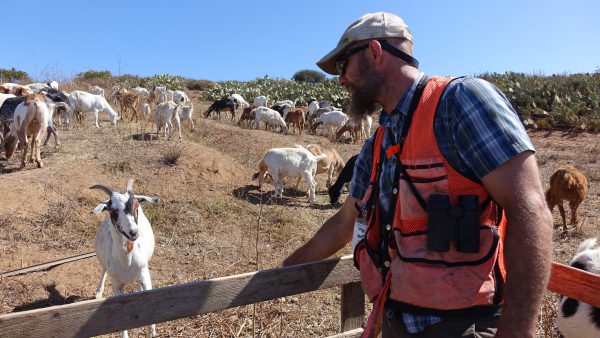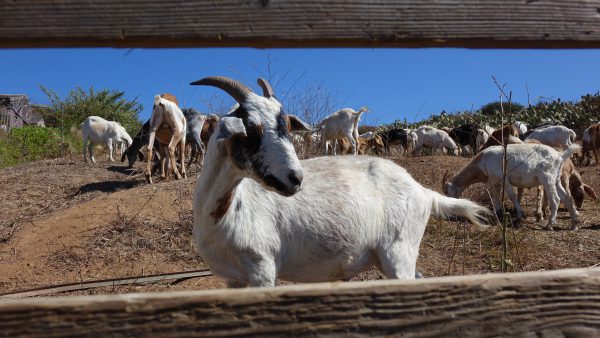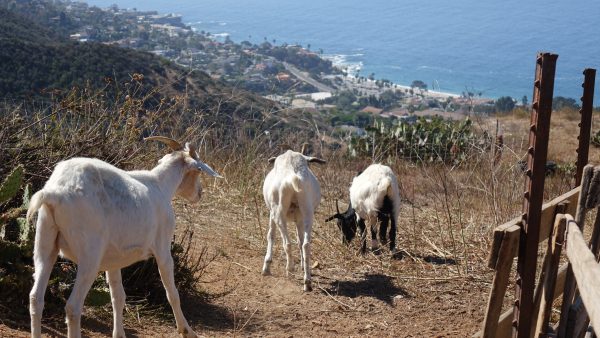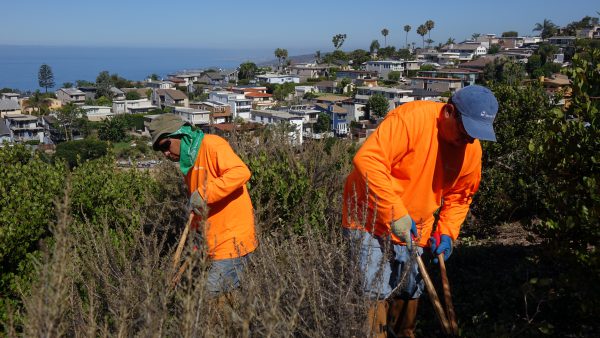By Daniel Langhorne, Special to the Independent


A heard of about 200 goats enjoyed a $4 million ocean view off Loretta Drive this week as they munched on dry grass and brush.
Laguna Beach deployed a third goat herd Aug. 15 to clear vegetation around Arch Beach Heights because of higher than average plant growth fueled by storms earlier this year. Grasses and scrub have dried over the summer, creating a tinderbox that could provide horrific conditions for a wind-driven wildfire.
The addition of furry firefighters brings the total number of goats serving Laguna Beach to 800, making it the biggest herd the city’s deployed in years.
“Due to the heavy rains last year, we’ve had a lot of vegetative growth here and it’s slow-going with our goats because there is so much of it,” Laguna Beach Fire Chief Mike Garcia said. “We haven’t had a third herd in years, but this year we need to bring them in to clear as much growth as we can before we move into the fire season.”
Nearly all of Laguna Beach and the surrounding 16,000 acres of open space in the Laguna Greenbelt are designated by CalFire as a “Very High Fire Hazard Severity Zone.” Laguna Beach maintains 292 acres of vegetation to mitigate its fire risk. Combined with another 25 acres that are privately maintained, these fuel modification zones protect about two-thirds of the city from wildfires. The city annually spends about $470,000 to maintain the zones.
Last year, Laguna Beach received a $4.2 million state grant to install a fuel modification zone in Laguna Canyon.
The estimated cost to complete fuel modification in the remaining third of Laguna Beach is $8 million. The city plans to apply for state funds to cover up to 75 percent of that cost.
The city’s goal for cutting vegetation back from homes is to reduce flame lengths approaching homes by up to 70 percent, said Mike Rohde, wildland fire defense program manager for Laguna Beach.

Goat grazing provides a relatively low-cost solution for overgrown brush, costing taxpayers $550 for every acre cleared. Laguna Beach is the only municipality in the Coastal Zone, which stretches from Oregon stateliness to the Mexican border, to have a goat grazing permit from the California Coastal Commission, Rohde said.
However, the herds are only allowed to eat non-native plants in areas that were historically grazed during Orange County’s cattle ranching days or disturbed by development.
South Laguna, for example, is home to southern maritime chaparral and coastal sage scrub that provides habitat for sensitive bird species. It’s also one of two places in the world to find bigleaf crownbeard, a cousin of sunflowers that’s threatened by the development on California’s coast.
Laguna Beach is mandated to protect these and other species by the California Coastal Commission, the California Department of Fish and Wildlife, and the U.S. Department of Fish and Wildlife. About 15 years ago, Laguna Beach was fined by the Coastal Commission for removing sensitive plants.
Laguna Beach fire officials find themselves stuck between a rock and a hard place. On one hand, they face incredibly intense pressure from multi-million-dollar property owners and their insurance companies to add fuel modification zones as quickly as possible. On the other, the city runs the risk of lawsuits from environmental advocates and/or being fined by state agencies if they don’t follow laws that protect sensitive plants and wildlife.
To avoid costly enforcement action, Laguna Beach has an agreement with the Laguna Canyon Conservancy to advise city staffers and contractors about what plants need to be preserved and to look for threatened wildlife.
“By partnering with the Laguna Canyon Foundation, we know we have someone out there at the site that really cares about preserving the Laguna environment,” Laguna Beach Fire Marshal James Brown said.
This week in scrub-filled Oro Canyon, which sits between Quivera and Miramar streets, the Laguna Canyon Foundation restoration program director, Alan Kaufmann, oversaw hand crews who use weed whackers, machetes and pruning shears to meticulously cut away invasive plants and give native plants the opportunity to thrive.
This labor-intensive work carries a price tag of $28,000 per acre and has to be maintained on a regular basis, or the plants will return to their overgrown state within two years, Rohde said. Besides their biodiversity value, native plants also protect homes by catching wind-blown embers that are notorious for destroying structures.
During the two to four weeks per year when Laguna Beach experiences Santa Ana winds, Arch Beach Heights would face a serious threat from a fire in Oro Canyon if the city didn’t have its fuel modification zone there, Rohde said.
“If we get a fire that wants to run in here on a bad day, we put at least 400 homes at risk,” he said.

Hand crew teams, consisting of about six to seven professional landscapers with Natures Image, just finished an area on a hillside near Barracuda Way.
Before the hand crews start working on a scrub patch, Kaufmann ties orange ribbons around sensitive plants that need to be preserved. State and federal wildlife officers routinely inspect the work to make sure it’s not disturbing species like the gnatcatcher.
“I think we can make an argument that we are improving the habitat and preserving the habitat,” said Kaufmann, who has a master’s degree in ecological restoration and forestry from Northern Arizona University. “It’s always a challenge because there are never enough resources to do what needs to be done.”
For the most part, Kaufmann said residents living near fuel modification zones understand their value, and some even wish the city would do more. “There’s a lot of eyes on the project,” he said.
Mike Beanan, of the Laguna Belt Coalition, said he expressed concerns at Monday’s Environmental Sustainability Committee meeting that the city bypassed environmental review of fuel modification zones, including the one east of Barracuda Way, by obtaining emergency permits from the Coastal Commission.
The goats’ feces can introduce non-native plants’ seeds into the environment and end up in the ocean after a rainstorm, Beanan said. He’d also prefer to see the city follow fuel modification guidelines in the General Plan. A more environmentally-sensitive strategy would include cutting 50 percent of the vegetation, irrigating with recycled wastewater, and scattering moisture-capturing mulch to stop flames, he added.
“There’s no reason for us to strip the sides of our hills when we have water,” Beanan said.
Sharon Fudge, a Laguna Beach resident and environmental advocate, said she’s also concerned about the environmental impacts of goat feces and urine washing downstream into the ocean. She highlighted that some native plants need an umbrella of other plants to be successful and questions how the hand crews incorporate that consideration into their landscape design.
But ultimately, Fudge praised the efforts of the city to reduce fire risk.
“I think that the city’s desire to do fire mitigation is certainly a worthy cause, because they don’t want to be in the same position as other cities that didn’t take measures,” she said.




